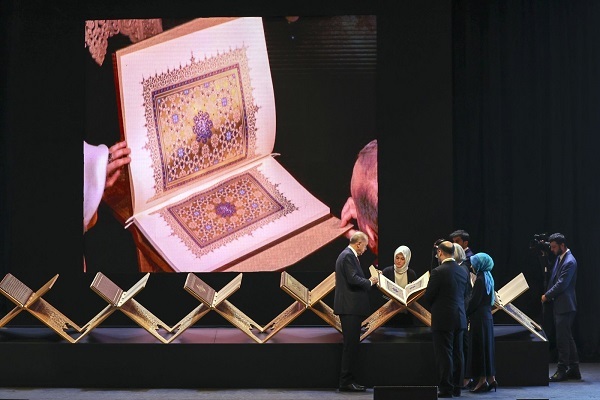Istanbul Mushaf Unveiled after Seven Years of Work

President Recep Tayyip Erdoğan joined other dignitaries as Turkey on Wednesday unveiled a handwritten Quran, known as a "mushaf," at the Grand Çamlıca Mosque in Istanbul.
Named after the city where it was written, the Istanbul Mushaf revives an abandoned tradition: decorating handwritten copies of Islam’s holy book. The day picked for the introduction of the mushaf coincided with Laylat al-Qadr, an Islamic holy night that is “more blessed than a thousand months,” according to Quran.
Erdoğan was the patron of the seven-year effort to handwrite the Quran, which continued the “nakkaşhane” tradition that faded away in the 18th century. Nakkaşhane is the name given to royal design ateliers that were parts of the Ottoman palaces or situated near the palace. The ateliers provided working quarters for every artist and artisan, from painters to stone carvers and those who specialized in designing the covers and pages of the Quran with Islamic motifs.
The mushaf consists of 10 volumes written and designed by a team of 66 experts, who specialized in a wide array of fields from tezhip (the art of illumination or ornamenting books with gold) to bookbinding and proteges of Hüseyin Kutlu, a renowned calligrapher and recipient of the Turkish Presidency’s Culture and Arts Award.
The team toiled in workshops at the Islamic Civilization Art Garden, a unique venue in Istanbul’s Kanlıca neighborhood that combines art facilities with gardens adorned with flowers often depicted in Islamic literature. There, they crafted every component of the mushaf, from its ink to paper. The handwritten book contains examples or a combination of examples from early calligraphy and other arts used in book design, from ancient Islamic civilizations and the early Ottoman era to the Mamluk Sultanate and the Moors of Spain.
Though the sacred book adheres to the exact text first written down as a compilation of verses during the time of Caliph Osman, it finds enough space on the margins of the pages to reflect a wealth of Islamic art. From the cover of the book to the upper sections of the pages where the name of every sura (chapter) is inscribed, every part of the book contains a form of art.
Some 1,000 copies of the book will also be printed and delivered to renowned mosques and libraries around the world, as well as to prominent clerics and heads of state of Muslim countries.
Source: Daily Sabah



